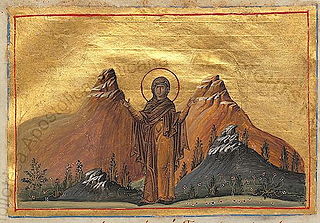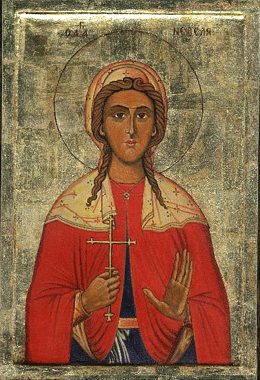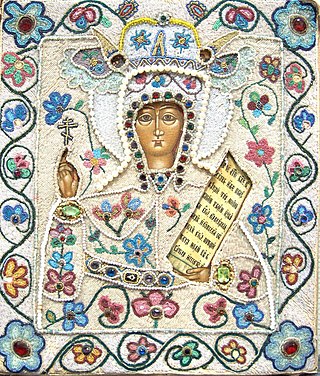
Saint George, also George of Lydda, was an early Christian martyr who is venerated as a saint in Christianity. According to tradition, he was a soldier in the Roman army. Of Cappadocian Greek origin, he became a member of the Praetorian Guard for Roman emperor Diocletian, but was sentenced to death for refusing to recant his Christian faith. He became one of the most venerated saints, heroes, and megalomartyrs in Christianity, and he has been especially venerated as a military saint since the Crusades. He is respected by Christians, Druze, as well as some Muslims as a martyr of monotheistic faith.

Catherine of Alexandria, also spelled Katherine is, according to tradition, a Christian saint and virgin, who was martyred in the early 4th century at the hands of the emperor Maxentius. According to her hagiography, she was both a princess and a noted scholar who became a Christian around age 14, converted hundreds of people to Christianity, and was martyred around age 18. More than 1,100 years after Catherine's martyrdom, Joan of Arc identified her as one of the saints who appeared to and counselled her.

Saint Demetriusof Thessalonica, also known as the Holy Great-Martyr Demetrius the Myroblyte, was a Greek Christian martyr of the early 4th century AD.

Mokosh is a Slavic goddess. No narratives survive to the present day about this deity and so scholars must rely on academic disciplines like philology to discern details about her.

Thecla was a saint of the early Christian Church, and a reported follower of Paul the Apostle. The earliest record of her life comes from the ancient apocryphal Acts of Paul and Thecla.

Cyricus and his mother Julitta are venerated as early Christian martyrs. According to traditional stories, they were put to death at Tarsus in AD 304.

Saint Anastasia is a Christian saint and martyr who died at Sirmium in the Roman province of Pannonia Secunda. In the Eastern Orthodox Church, she is venerated as St. Anastasia the Pharmakolytria, i.e. "Deliverer from Potions". This epithet is also translated as "One who Cures (Wounds)" in Lampe's A Patristic Greek Lexicon.
Saint Paraskevi may refer to:

Eudokia was a Samarian woman who lived in Heliopolis of Phoenicia.

Saint Sophia of Rome is venerated as a Christian martyr. She is identified in hagiographical tradition with the figure of Sophia of Milan, the mother of Saints Faith, Hope and Charity, whose veneration is attested for the sixth century.

Phanourios also known as Phanourios the Newly-Manifest is recognized as a saint by the Eastern Orthodox Church and the Roman Catholic Church. He is commemorated on August 27.

Saint Paraskevi of Rome is venerated as a Christian martyr of the 2nd century. She was arrested on multiple occasions for her Christianity and was eventually beheaded by the Roman governor Tarasius.

Paraskeva of the Balkans was an ascetic female saint of the 11th century. She was born in Epivates, near present-day Istanbul, and had visions of the Virgin Mary. After living in Chalcedon and Heraclea Pontica, she settled in a convent in the desert near the Jordan River. An angel told her to return to her homeland, and two years later she died at the age of 27. The cult of Saint Paraskeva began to spread in the 14th century from Bulgaria into the Danubian Principalities of Wallachia and Moldavia. There was confusion over her identity and attributes because her Greek name Παρασκευή "Paraskeuḗ, Paraskevi" means "Friday," and translations in other languages, such as Romanian and Serbian, were "Saint Friday". Her cult continues to be celebrated in many Orthodox countries, and her feast day is commemorated on October 14 in the Eastern Orthodox Church.

Saint Venera is venerated as a Christian martyr of the 2nd century. Little is known of this saint. The date of her death is traditionally given as July 26, 143 AD.
Agia Paraskevi is a village and a community of the Meteora municipality. Before the 2011 local government reform it was part of the community of Aspropotamos, of which it was a communal district. Now Aspropotamos is a municiplal unit. The 2021 census recorded 30 permanent residents in the village. In the summer season the number expands considerably as former residents and other tourists come to vacation. The community of Agia Paraskevi covers an area of 29.641 km2.

Folk Orthodoxy refers to the folk religion and syncretic elements present in the Eastern Orthodox communities. It is a subgroup of folk Christianity, similar to Folk Catholicism. Peasants incorporated many pre-Christian (pagan) beliefs and observances, including coordinating feast days with agricultural life.

Saint Nedelya (St. Sunday, St. Anastasia, in folk Orthodoxy of the Slavs is the personification of Sunday as day of the week. It is correlated with Saint Anastasia (in Bulgarians also with Saint Kyriakia. The veneration of the Week is associated with the prohibition of various kinds of work.

In the folk Christianity of Slavic Eastern Orthodox Christians, Paraskeva Friday is a mythologized image based on a personification of Friday as the day of the week and the cult of saints Paraskeva of Iconium, called Friday and Paraskeva of the Balkans. In folk tradition, the image of Paraskeva Friday correlates with the image of Saint Anastasia of the Lady of Sorrows, and the Saint Nedelya as a personified image of Sunday. Typologically, Paraskeva Pyatnitsa has parallels with day-personifications of other cultures, for example, the Tajik Bibi-Seshanbi.
















